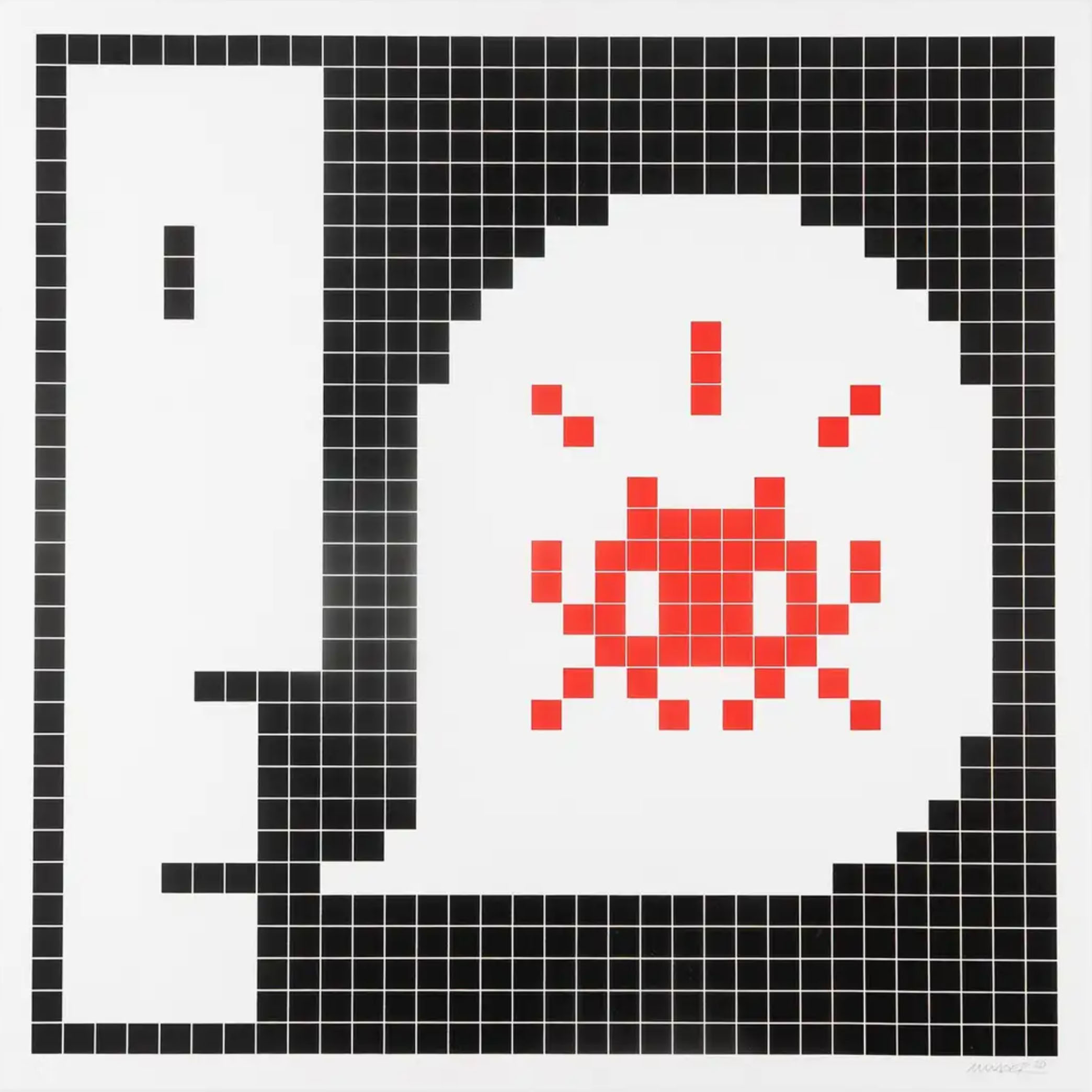In October 2005, the elusive street artist Banksy curated a thought-provoking exhibition titled “Crude Oils” at a small gallery in the bustling neighbourhood of Notting Hill in London.
The exhibition displayed twenty classical oil paintings that he had purchased from various flea markets across London. The paintings were ingeniously modified to incorporate motifs of contemporary social decline, which gave them a unique and provocative artistic twist.
In addition to the paintings, the exhibition also featured a collection of distinctive sculptures that were equally thought-provoking. As if that wasn’t enough, the exhibition was also graced by the surreal presence of 167 live rats, which added to the overall eccentricity and unpredictability of the show.
“Rats represent the triumph of the little people. The undesirables and the unloved. Despite the efforts of the authorities, they’ve survived, they’ve flourished, and they’ve won. Wherever you stand in London, you’re never more than 10 foot away from someone who knows a boring fact about rats.”
Banksy
Despite protests from some neighbouring businesses, environmental health officers conducted a thorough inspection of the facility and found everything to be entirely safe and in perfect order.
We look at some oil paintings Banksy skillfully altered to include modern themes and political messages in pastoral landscapes. From juxtaposing serene countryside settings with bold political statements to adding unexpected elements to classic portraits, Banksy’s ability to seamlessly blend the old with the new is legendary. Let’s unravel the intricate details and hidden meanings behind his gallery exhibition of re-mixed masterpieces, vandalism and vermin.
Sunflowers from Petrol Station
The painting Sunflowers from Petrol Station, once owned by the renowned British fashion designer Sir Paul Smith, is said to be a Banksy masterpiece. It is a clever reinterpretation of Vincent Van Gogh’s Sunflowers, portraying the Dutch artist’s vibrant yellow blooms as a cluster of dried and withered stems. Through the depiction of wilted petrol station flowers, the artist highlights the harmful effects of consumerism on both art and nature.
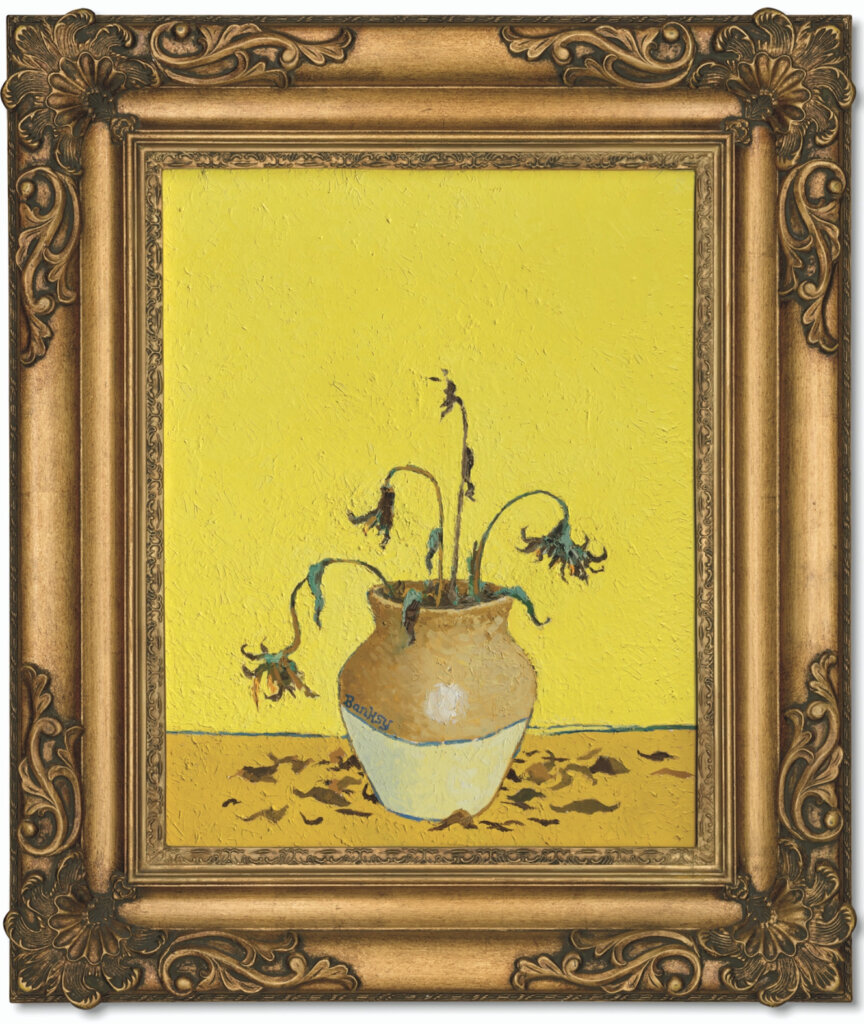
Banksy, Sunflowers from Petrol Station (2005)
Show Me the Monet
Show Me the Monet is an impressive artwork that solidified Banksy’s reputation as a bold and thought-provoking social commentator of our time. Banksy cleverly reimagines an iconic image from Western art history, delivering a witty commentary on contemporary issues.
“The vandalised paintings reflect life as it is now. We don’t live in a world like Constable’s Haywain anymore and, if you do, there is probably a travellers’ camp on the other side of the hill. The real damage done to our environment is not done by graffiti writers and drunken teenagers, but by big business… exactly the people who put gold-framed pictures of landscapes on their walls and try to tell the rest of us how to behave.”
Banksy
The painting features fly tipping of an orange traffic cone and shopping trolleys, disrupting the romanticised nature of Monet’s famous Impressionist masterpiece and creating a modern-day dumping ground.
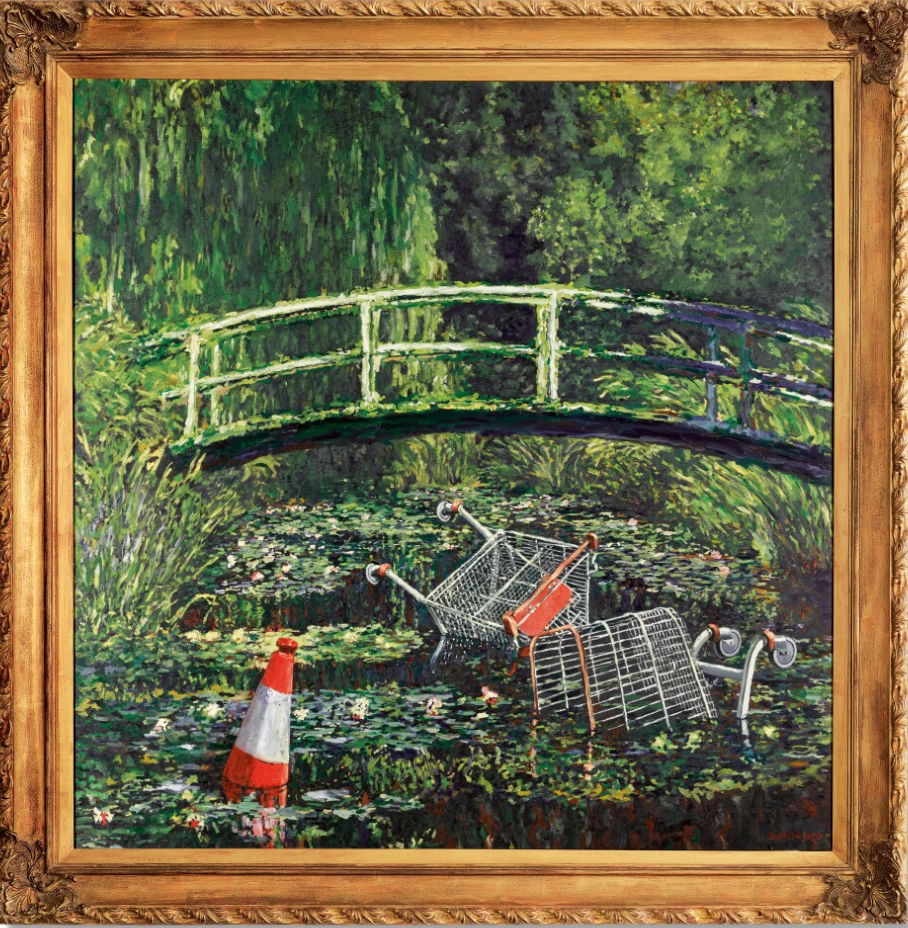
Banksy, Show Me the Monet (2005)
TOX Cottage
TOX Cottage may be an ode to “King of the Taggers”. TOX is known for the prolific tagging of railway sidings and other public spaces, which led to accusations of vandalism and criminal damage. Despite being called the “King of the Taggers” by some niche magazines, TOX was found guilty in court and warned he may face prison. In contrast, Banksy’s work is viewed as art rather than vandalism, with the council even protecting one of his murals with a Perspex screen and considering insuring it. TOX was mocked as ‘no Banksy’ by the prosecution due to his lack of creative artistry with his graffiti works. In 2011, a Banksy stencil figure of a boy playing with bubbles which read TOX appeared on Jeffrey Street in Camden in June 2011.
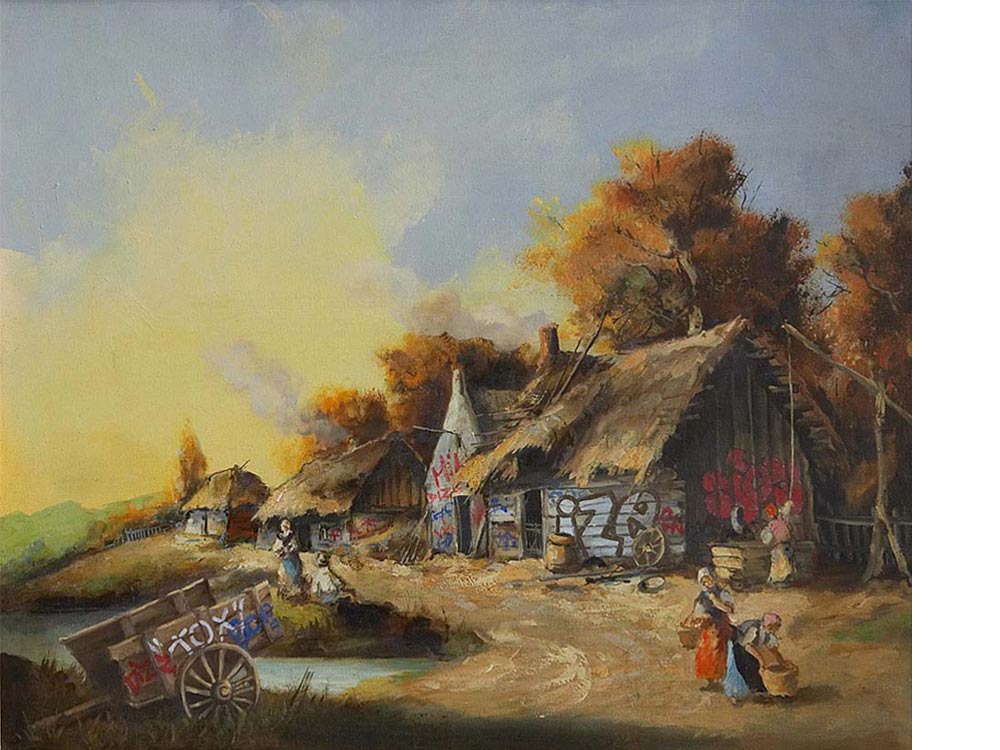
Banksy, TOX Cottage (2005)
CCTV
The painting depicts a rural area with a CCTV camera perched atop a pole overlooking the countryside. The camera imitates an eagle, its beady eyes peering down on the landscape below and its prey. The painting is a commentary on the ever-increasing surveillance that permeates our society and how our privacy is being eroded in the name of security.
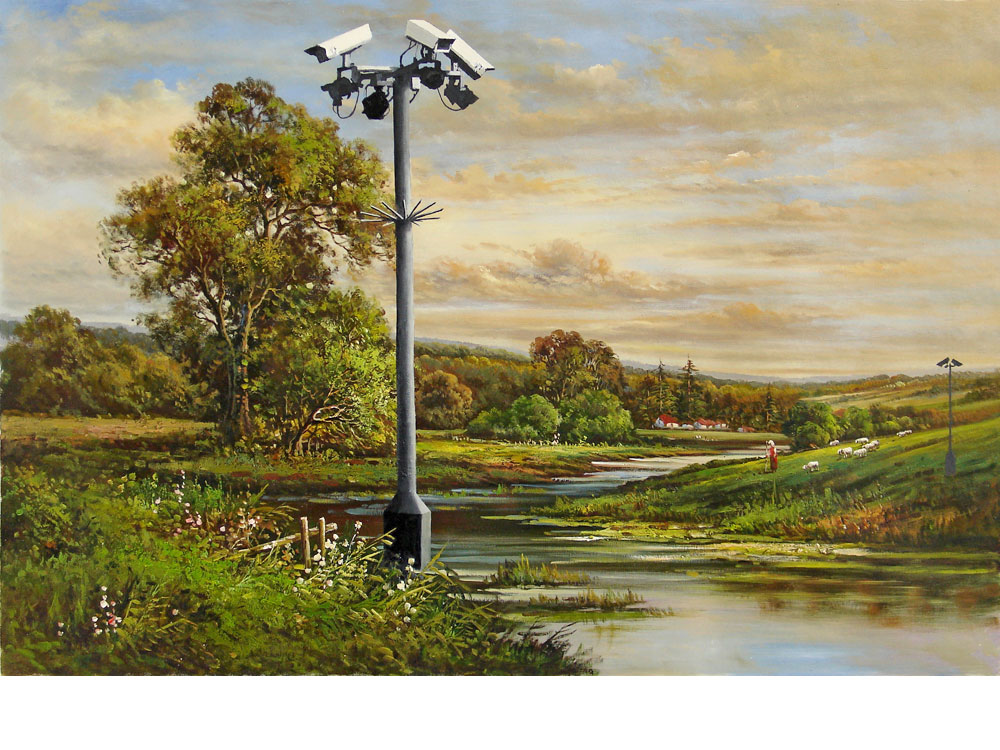
Banksy, CCTV (2005)
Car Wreck
The artwork “Car Wreck” is a revamped classic painting that showcases a contemporary ruined car set in a rural backdrop. It’s a powerful commentary on the collision of modernity and tradition and how our world is rapidly changing. Banksy uses his art to challenge our assumptions and make us think more deeply about the world it is today.
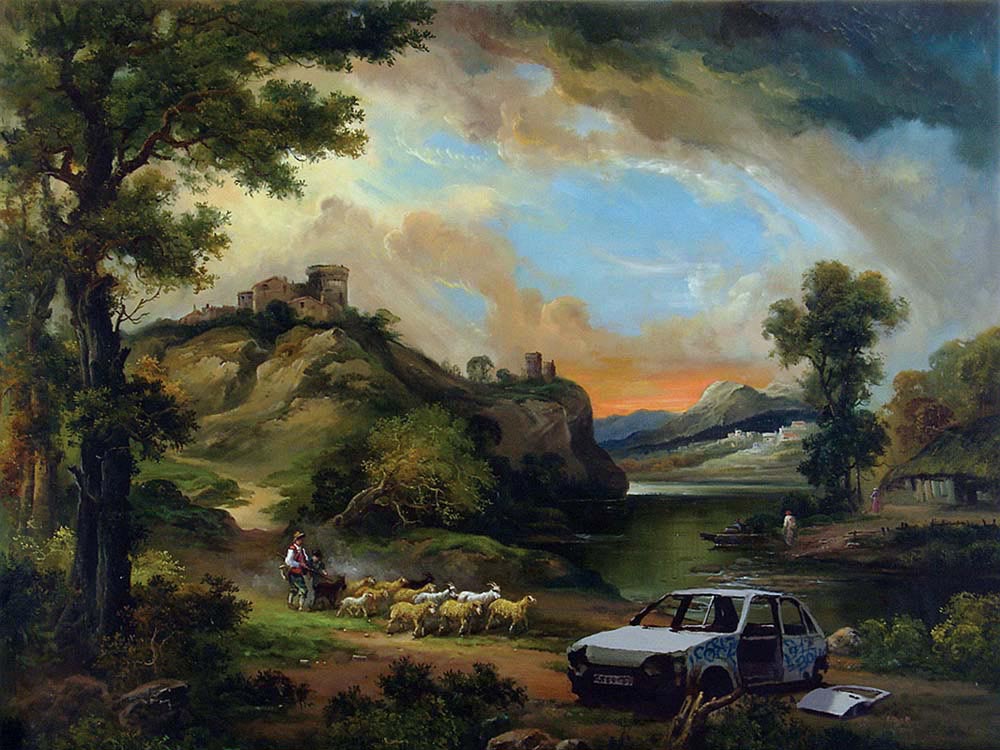
Banksy, Car Wreck (2005)
Incident
The Police Incident sign used as a motif in Banksy’s “Crude Oils” exhibit was intentionally placed amongst the rural and serene landscape to indicate that something bad has happened. It is a commentary on how even though a place may appear peaceful and beautiful on the surface, it can be plagued by problems such as pollution. The juxtaposition of the idyllic landscape with the ominous sign serves as a reminder that not everything is as it seems.
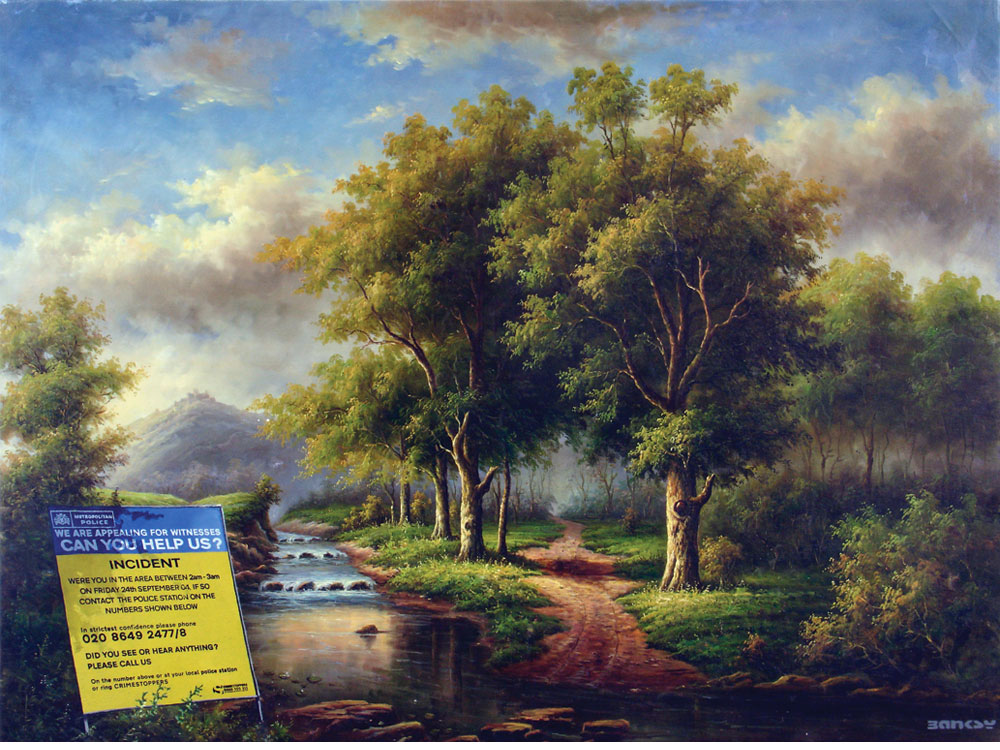
Banksy, Incident (2005)
Crude Oils (Vettriano)
‘Crude Oils (Vettriano)’ by Banksy is based on self-taught Scottish painter Jack Vettriano’s “The Singing Butler”, which became a best-selling image in Britain in 1992. Vettriano’s “The Singing Butler” sold at auction in 2004 for a record-breaking £744,800, making it the best-selling art print in the UK.
Banksy’s reinterpretation of Jack Vettriano’s ‘The Singing Butler’ takes a poignant turn, moving away from the original romantic depiction of a couple dancing on the beach alongside their maid and butler. Instead, Banksy emphasizes pressing contemporary issues like environmental degradation and pollution. By replacing the maid with two men in hazmat suits transporting toxic waste, he powerfully critiques the ongoing environmental crises we continue to confront today. This subversion not only alters the painting’s narrative but also serves as a stark reminder of the impact of human activity on our planet.
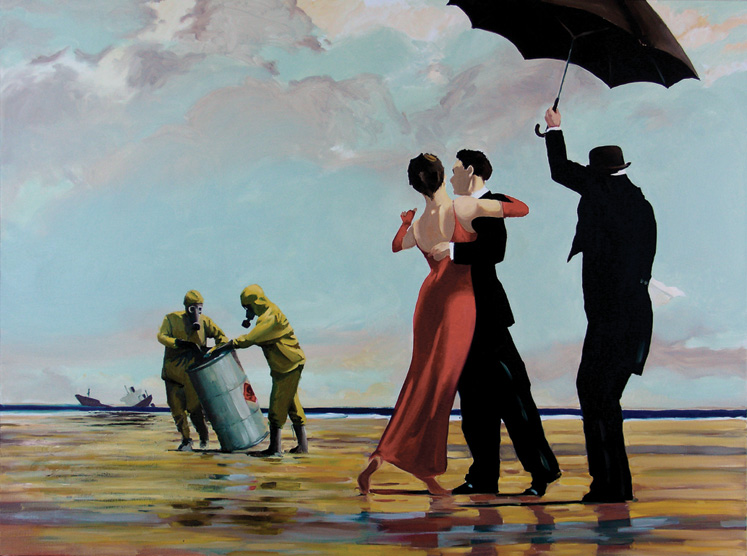
‘Crude Oils (Vettriano)’ by Banksy (2005)
Banksy’s “Crude Oils” exhibit was a transformative experience for its viewers. It was a perfect representation of the artist’s views on the world and how it has changed over time. He believed the vandalised paintings reflected the reality of life as it is now, as opposed to the idealised scenes of artists such as Constable. According to Banksy, “the real damage done to our environment is not done by graffiti writers and drunken teenagers, but by big business… exactly the people who put gold-framed pictures of landscapes on their walls and try to tell the rest of us how to behave.“
If you’re interested in viewing Banksy’s artwork, you can check out our online store. Alternatively, if you have a particular piece in mind or would like to enquire about a specific artwork, feel free to contact us, and we’ll be happy to assist you.
Image @ Banksy
